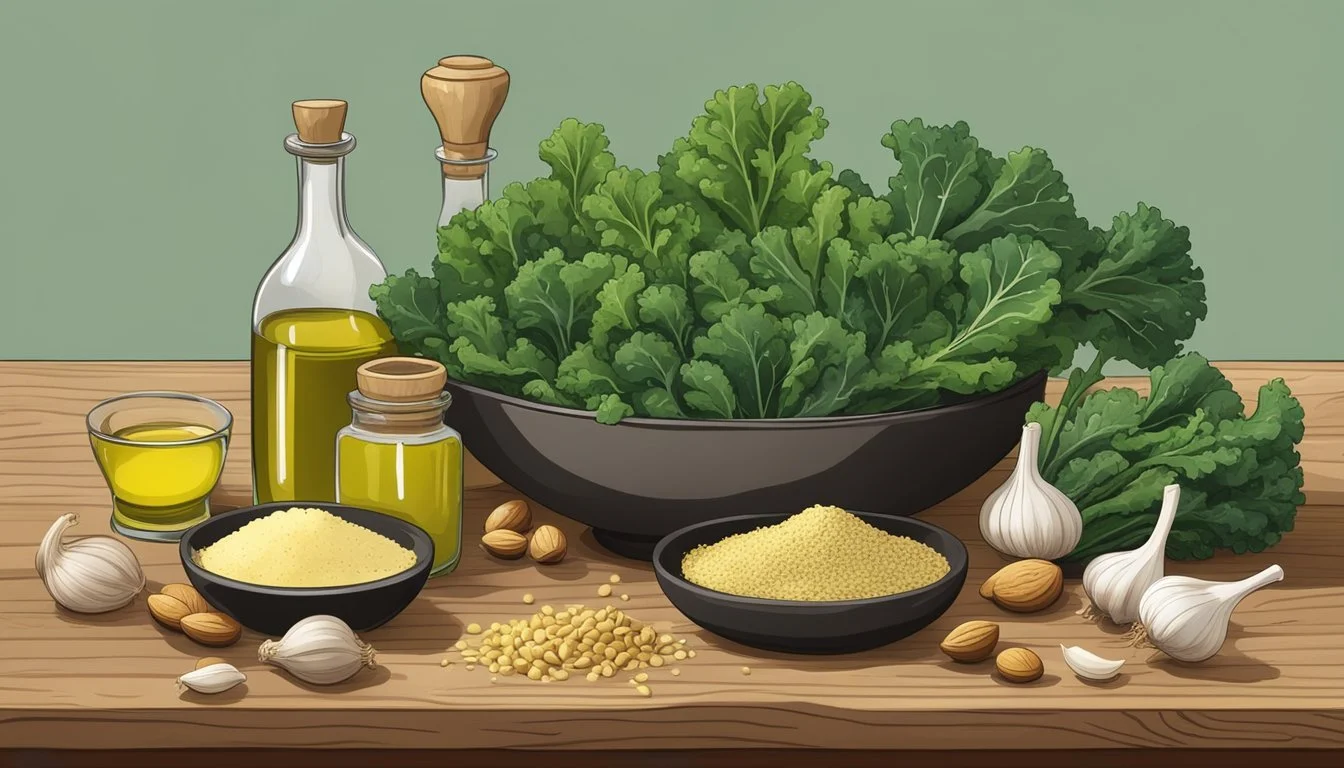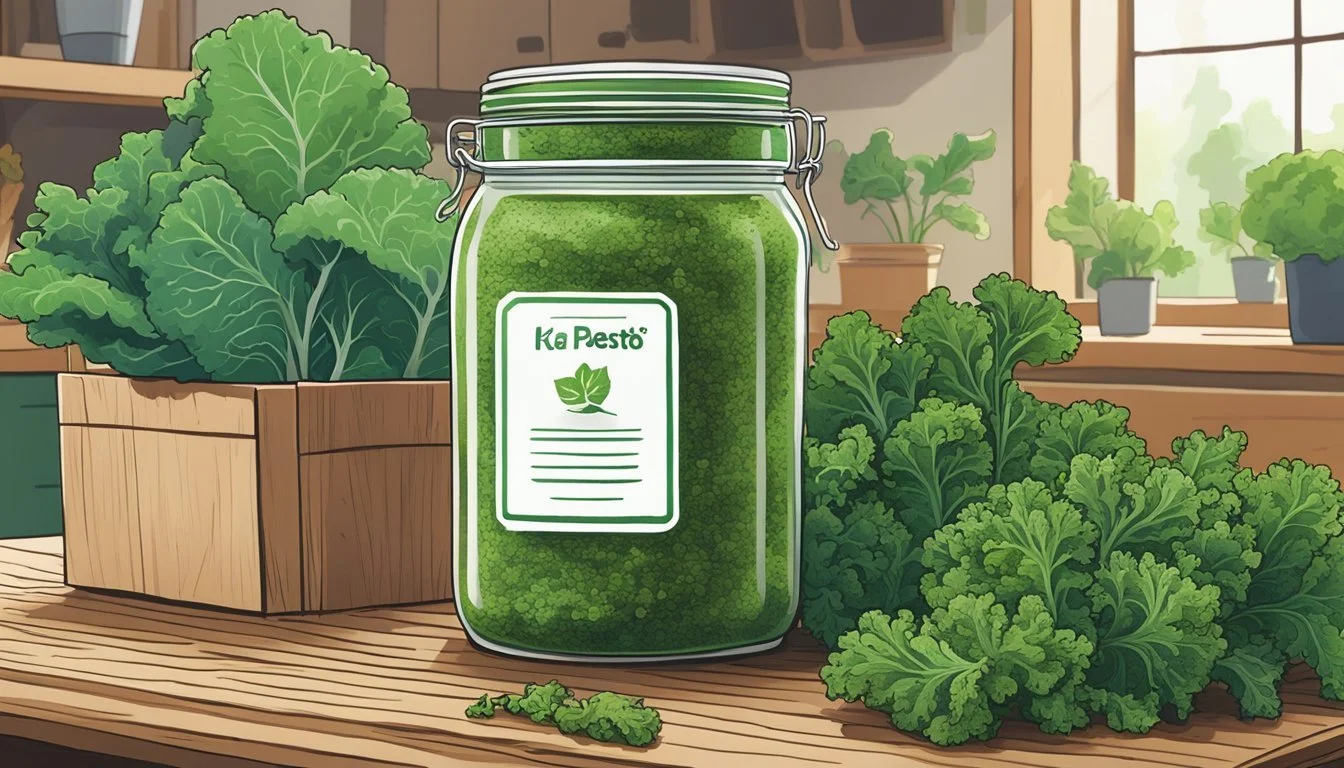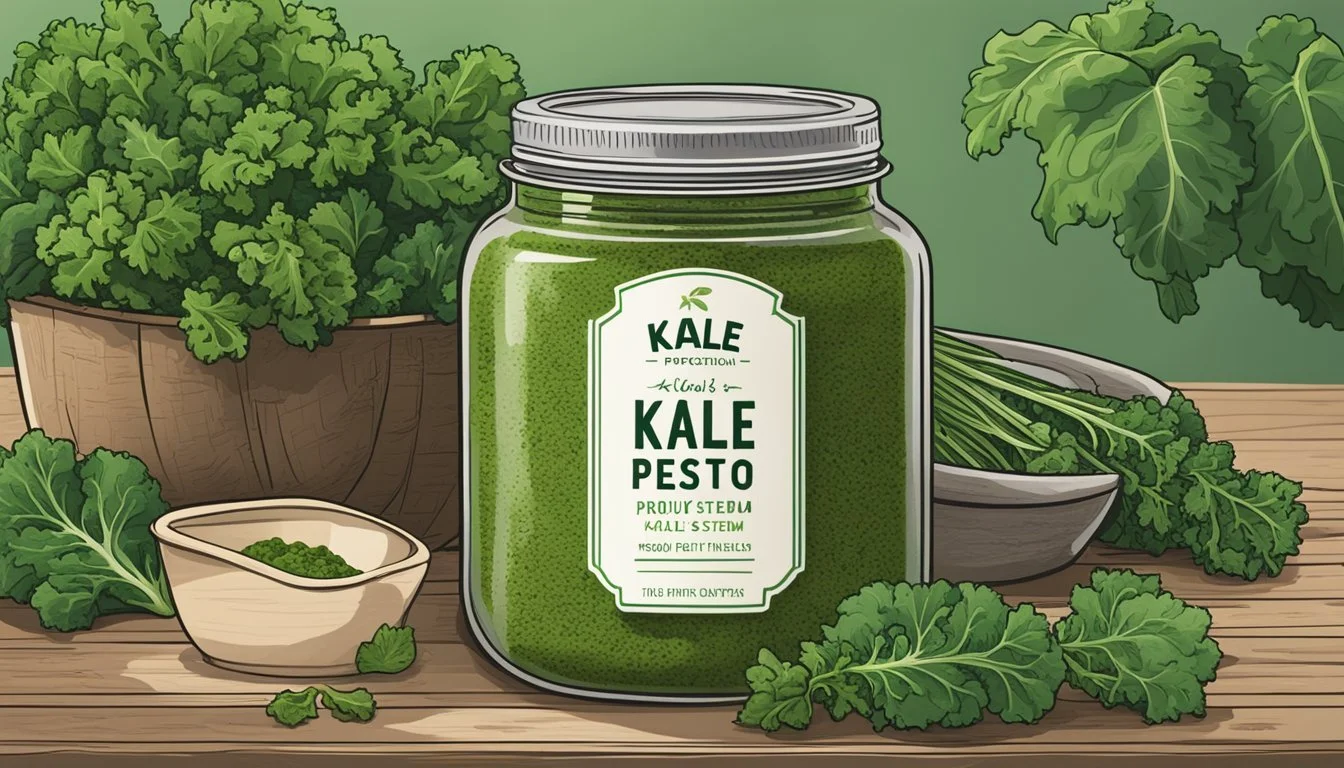Kale Stem Pesto
A Nutrient-Packed Spread for Sustainable Cooking
Pesto is a versatile sauce historically rooted in Italian cuisine, traditionally made with basil, pine nuts (What wine goes well with nuts?), Parmesan cheese, garlic, and olive oil. It has, however, evolved into myriad variations, incorporating different herbs, nuts, and greens. Kale (What wine goes well with kale?) stem pesto is a vibrant twist on the classic, utilizing a part of the plant often discarded. This resourceful use of kale stems not only reduces food waste but also imparts a robust, earthy flavor and adds a significant nutritional boost to meals.
Crafting pesto with kale stems is an ingenious way to take advantage of the entire vegetable. Kale, a nutrition powerhouse, is rich in vitamins A, C, and K, along with antioxidants and fiber. By incorporating the stems into pesto, one harnesses these nutrients that might otherwise be overlooked. Kale stem pesto can be enjoyed as a spread on sandwiches, swirled into pastas, or used as a dipping sauce, introducing a delightful depth to various dishes.
The process to create this green concoction begins by cooking the kale stems until tender, then blending them with traditional pesto components like garlic, nuts, cheese or nutritional yeast, and a stream of olive oil. The result is a flavorful, thick sauce that stands confident in its uniqueness while offering a diverse usage in the culinary world. While some prefer their pesto smooth, others might appreciate a more textured spread, both of which are easily achievable with slight adjustments in the blending process.
The Basics of Kale Pesto
Kale pesto merges the traditional elements of pesto with the nutritional vigor of kale. It serves as a versatile spread, offering a healthy twist on an Italian classic.
Defining Pesto
Pesto is a sauce that originates from Genoa, the capital city of Liguria, Italy. Traditionally, pesto is a mixture of basil, garlic, pine nuts, Parmesan cheese, and olive oil. The ingredients are usually combined in a food processor or ground with a mortar and pestle to create a thick, green sauce. It is renowned for its bold flavor and is often used to dress pasta, spread on sandwiches, or as a dip.
Kale as a Central Ingredient
Although basil is the main green in classic pesto, kale stands out as a nutrient-dense substitute. Kale brings a hearty, earthy flavor to the pesto and is packed with vitamins A, K, C, and minerals like potassium and magnesium. When preparing kale for pesto, it's crucial to remove the woodier stems and chop the leaves finely. Ingredients such as nuts (pine nuts, walnuts, or almonds), garlic, and Parmesan or nutritional yeast are combined with the kale. Opting for nutritional yeast can make the pesto vegan-friendly. The ingredients are emulsified with a quality olive oil to obtain the right consistency, balancing the robust flavors of kale with the richness of olive oil and the savory depth of cheese or yeast.
Nutritional Profile of Kale Pesto
Kale pesto combines the nutritional powerhouse of kale with other wholesome ingredients, offering a spread that's not only flavorful but also rich in essential nutrients.
Vitamins and Minerals in Kale
Kale, the main ingredient in kale pesto, is a leafy green that boasts a high concentration of vitamins and minerals. It is particularly rich in:
Vitamin C: Crucial for the immune system and skin health.
Vitamin A: Important for vision and the immune system.
Calcium: Essential for bone health.
Potassium: Beneficial for heart health.
Iron: Necessary for oxygen transport in the blood.
These vitamins and minerals contribute to the overall nourishing profile of kale pesto.
Health Benefits of Nutrient-Dense Ingredients
The synthesis of nutrient-dense ingredients in kale pesto translates into several health benefits. The inclusion of garlic, nuts, and nutritional yeast or Parmesan enriches the pesto with:
Fiber: Aids in digestion and promotes a feeling of fullness.
Protein: Fundamental for muscle repair and growth.
Healthy fats from nuts: Important for brain health and hormone production.
By incorporating these ingredients, kale pesto becomes a nutritious option that supports various aspects of health.
Preparing Kale Pesto
Kale pesto offers a flavorful and nutrient-rich option for spreads or pasta sauces. When made correctly, it strikes a balance between robust flavors and a creamy texture, providing a versatile addition to various dishes.
Ingredient Selection
Selecting quality ingredients is crucial for a flavorful kale pesto. Fresh kale leaves should be vibrant and free from blemishes. For the garlic, choose plump cloves for a more intense flavor. A high-quality extra-virgin olive oil can greatly enhance the taste, while a pinch of salt balances the flavor profile. Options for nuts include traditional pine nuts or alternatives like pistachios or walnuts. Incorporate fresh lemon juice for added brightness. Vegans can substitute cheese with nutritional yeast to maintain a cheesy flavor profile.
Greens: Pick fresh, vibrant kale leaves.
Garlic: Use fresh plump cloves.
Nuts: Choose from pine nuts, walnuts, or pistachios.
Oil: Opt for high-quality extra-virgin olive oil.
Acid: Fresh lemon juice brightens the flavor.
Salt and Pepper: To taste, for balance.
Vegan Options: Nutritional yeast can replace cheese.
Using a Food Processor
Employing a food processor simplifies the task of creating a consistent mix. Start by pulsing the harder ingredients such as nuts, garlic, and kale stems, if using, until they become crumbly. This step ensures even blending. Next, add the softer items like kale leaves, lemon juice, and, if desired, cheese or nutritional yeast.
Initial Pulse: Begin with nuts, garlic, and kale stems.
Add Greens: Follow with kale leaves and softer ingredients.
Combining: Pulse until components are well-integrated.
Achieving the Perfect Consistency
The texture of kale pesto can be customized according to personal preference. For a smoother paste, continue processing the mixture, gradually adding olive oil as the food processor runs. If a thicker consistency is preferred, use less oil and process for a shorter time. Adding a bit of water can help emulsify the pesto without making it too rich.
Olive Oil: Add gradually while processing for smoothness.
Water: Use sparingly to adjust thickness and prevent over-richness.
Final Texture: Process to desired consistency, either smooth or with some texture remaining.
Creative Ways to Enjoy Kale Pesto
Kale pesto serves as a versatile and flavorful addition to a range of dishes, elevating their taste profile while boosting nutritional content. Discover innovative ways to incorporate this nutrient-packed spread into your meals.
Pasta Dishes
Kale pesto pasta can redefine the classic pasta experience. Instead of traditional sauces, one can toss al dente pasta with kale pesto for a nutritious and palatable meal. For an added crunch and nuttiness, sprinkle toasted walnuts or sunflower seeds on top. This sauce pairs exceptionally well with pasta types that hold onto sauces, like fusilli or penne.
Diverse Salads
Kale pesto doubles as a salad dressing, imparting a savory note to green salads. Drizzle it over a bed of mixed greens, cherry tomatoes, and a selection of your favorite vegetables for an easy, healthful, and satisfying meal. It's especially good when combined with roasted vegetables, creating a harmonious blend of tastes and textures.
As a Dip or Spread
As a dip, kale pesto can be served with sliced raw vegetables, such as carrots, celery, or bell peppers. It also works wonderfully as a spread for sandwiches, replacing mayonnaise or mustard, providing a richer flavor profile that compliments a variety of fillings.
Innovative Recipes
Get creative with kale pesto by using it as a marinade for meats, or incorporate it into quiches or savory baked goods for a burst of herby goodness. It can also be added to frittatas or scrambled eggs, injecting more flavorful and colorful moments into breakfast or brunch dishes (What wine goes well with brunch dishes?).
Pro Tips for Making Kale Pesto
Crafting the perfect kale pesto involves wise ingredient selection and proper storage methods to retain its bold flavors and health benefits.
Optimizing Ingredient Ratios
For a well-balanced flavor, adhering to proper ingredient ratios is paramount. A general guideline is to use:
3 cups of kale leaves: this will provide the base of the pesto and is ideal for a standard batch.
2 garlic cloves: critical for a sharp depth of taste.
1/4 cup of nuts: pistachios or walnuts are excellent choices for added texture and richness.
1/2 tsp of salt: to elevate the other flavors.
1 tablespoon of lemon juice: for a bright, citrusy note.
1/4 cup of grated parmesan or nutritional yeast: Parmesan adds a nutty sharpness, while nutritional yeast can serve as a substitute for a dairy-free version.
1/2 cup of extra-virgin olive oil: drizzle in slowly to achieve a smooth, emulsified consistency.
Storage and Preservation
To maintain the pesto's freshness, storing it properly is key.
In the refrigerator: store the pesto in an airtight container with a layer of olive oil on top to prevent oxidation. It will keep for up to a week.
To freeze: portion the pesto into ice cube trays and freeze. Transfer the frozen cubes into a freezer bag or container to keep for several months. Thaw in the refrigerator when ready to use.
Using Leftover Kale Stems
Don't waste leftover kale stems; they are full of nutrients and fiber.
Chop the stems and simmer them in water with a pinch of salt until tender, about 20 minutes.
Cool and blend the stems as you would with the leaves. They can be a great substitute or addition to the leaf-based pesto, adding a unique texture and flavor while reducing food waste.
Preparing pesto with these tips will ensure delicious results that can be enjoyed immediately or saved for later use.
Pairings and Serving Suggestions
Kale stem pesto, rich in nutrients, offers a fresh, hearty flavor with a slight zesty kick from lemon zest. This versatile spread elevates a variety of dishes and pairs excellently with certain wines.
Best Pairings with Pastas and Grains
Kale stem pesto is a flavorful complement to pasta varieties. One can blend this pesto with:
Linguine or ziti, allowing the sauce to cling to every strand and tube.
Filled pastas like tortellini, bringing out the savory filling.
Risotto, where a good dollop of pesto can be stirred in to create an herbaceous and creamy dish.
For a complete meal, consider whole grains as a base:
Mix pesto into quinoa or farro for a nutrient-dense side.
Wine Pairings
When considering wine pairings, the goal is to complement the vibrancy of the pesto.
A crisp Sauvignon Blanc matches the brightness of the pesto and enhances its lemony notes. A table showcasing the pairings could look like this:
Pesto Component Wine Suggestion Lemon zest Sauvignon Blanc Earthy greens Vermentino Nutty richness Light-bodied Chardonnay
Accompaniments and Side Dishes
Kale pesto serves well as a flavorful addition to various accoutrements and sides:
Slather on crostini and top with a thin slice of red onion for a light appetizer.
Brush over vegetables before grilling to impart a savory note.
Use as a side with grilled chicken or fish, creating a balance with leafy greens’ benefits.
For pickling enthusiasts, kale pesto pairs remarkably with pickled vegetables, (What wine goes well with pickled vegetables?) offering contrasting flavors that delight the palate.
Variations and Substitutions
Kale stem pesto is a flexible recipe that caters to various dietary needs and preferences. With straightforward substitutions, one can easily adapt the recipe to be dairy-free, nut-free, or to incorporate a variety of fresh herbs.
Non-Dairy and Vegan Options
To accommodate a vegan or dairy-free diet, one must replace traditional dairy components like Parmesan cheese. Nutritional yeast is a popular substitute, imparting a cheesy flavor without the use of actual dairy. Moreover, vegan Parmesan—found in health food stores—can also be a direct substitute. Olive oil serves as a suitable vegan-friendly binder for the pesto.
Nut-Free Alternatives
Pesto typically contains nuts—to replace them in a nut-free version, seeds such as pumpkin seeds or sunflower seeds come in handy. These seeds offer the texture and richness nuts provide, without the allergens. Their use makes the pesto safe for individuals with nut allergies while still contributing to the overall flavor.
Herb Variations
While basil is the traditional herb in pesto, variations can include a range of green leafy alternatives. Fresh basil can be substituted in part or wholly with collard greens to add different flavor profiles and nutritional benefits. Incorporating these greens adds versatility and makes the pesto suitable for those who can't consume basil for dietary reasons. Additionally, one might consider a mixture of herbs, such as parsley or cilantro, to customize the taste.
These adaptations not only extend the pesto's appeal to a broader audience but also allow for personalization according to taste and dietary restrictions.
FAQs About Kale Pesto
When making kale pesto, individuals often have questions regarding the recipe's ingredients, preparation techniques, and vegan alternatives. This section aims to address these concerns through helpful insights and practical tips.
Addressing Common Concerns
Is garlic necessary in kale pesto? Garlic adds a distinctive flavor, but its usage can be adjusted to taste. One or two cloves are commonly used, but it can be omitted or reduced for a milder pesto.
Can I make kale pesto without cheese? Yes, for a vegan version, one can substitute traditional cheese with nutritional yeast to mimic the cheesy flavor while keeping the recipe dairy-free.
What's the best way to use a food processor for kale pesto? To create a uniformly textured pesto, pulse the ingredients in the food processor until they reach the desired consistency, scraping down the sides as needed.
Can kale pesto be frozen? Certainly, kale pesto freezes well. Store it in an airtight container, and it can last for several months in the freezer.
Tips for First-Timers
Choosing Ingredients:
Select fresh kale leaves; remove woodier stems as they can be fibrous.
Use high-quality extra-virgin olive oil for a rich flavor.
Consider toasted nuts (like pine nuts or pistachios) to add depth.
Preparation Tips:
Add ingredients gradually: Start with kale and nuts, then incorporate cheese or nutritional yeast, and finally the olive oil.
Season with salt sparingly and adjust to taste.
For those aiming for a smoother texture, blend for a longer period. For more texture, a shorter pulse time works best.
The Culinary Context of Kale Pesto
In the culinary world, kale pesto stands out as a versatile and nutritious addition to various dishes. It has been repurposed from classic Italian cuisine, infusing meals with a vibrant green hue and a nutritious punch.
Historical Background
Kale pesto's roots trace back to the Italian "pesto," which means "to pound" or "to crush," pertaining to the traditional method of making pesto in a mortar and pestle. Initially, pesto was made with basil, pine nuts, garlic, Parmesan cheese, and olive oil. Over time, adaptations like kale pesto have emerged, utilizing the often-discarded stems of kale to create a sustainable and health-conscious variant of the beloved sauce.
Kale Pesto in Modern Cuisine
Today, chefs and home cooks alike incorporate kale pesto into a multitude of recipes, reflecting contemporary dining sensibilities that prioritize creativity and nutritional value. It has made its way as a flavorful addition to dishes such as:
Pasta: Enhancing spaghetti, orzo, and lasagna with its rich, earthy flavors. (What wine goes well with earthy flavors?)
Soups: Offering a nutrient boost as a garnish or flavor base in various soups.
Food Bowls: Serving as a savory component in health-focused grain or salad bowls.
Dinner Spreads: Acting as a condiment alongside bread or as a marinade for proteins.
In modern diets that celebrate plant-based ingredients, kale pesto adapts seamlessly, reflecting the evolution of food culture that marries taste with health.
Sourcing Ingredients and Tools
Before making kale stem pesto, sourcing high-quality ingredients and the right kitchen tools is crucial. This ensures the pesto is nutritious and flavorful while also making the preparation process smooth and efficient.
Selecting Quality Kale
When choosing kale for pesto, consumers should look for organic kale, which can often be found at local farmers markets or grocery stores. Freshness is key, so they should ensure the kale has firm stems and vibrant green leaves, signs of its quality and nutrient content.
Finding the Right Equipment
For the preparation of kale stem pesto, a sturdy food processor is essential. It should be powerful enough to blend the tough kale stems into a smooth paste. Customers might find a suitable food processor at kitchenware stores or larger supermarkets, which often stock a range of models suitable for this task.
Advanced Kale Pesto Techniques
In this section, readers will explore advanced techniques that chefs use to enhance both the flavor and presentation of kale pesto, including professional cooking methods and tips for elevating the taste profile.
Professional Cooking Techniques
Blanching: A critical step in preparing kale pesto is to blanch the kale leaves briefly before processing. This technique not only brightens the color of the kale but also softens its texture, making for a smoother pesto.
Emulsion: Professional chefs emphasize the importance of creating a stable emulsion. They gradually add oil to the food processor while it's running to ensure the mixture emulsifies properly, giving the pesto a creamy and cohesive texture.
Elevating Flavors
Nuts and Seeds: Before incorporating nuts or seeds into the pesto, toasting them in a dry skillet can greatly enhance their flavor, adding a depth that raw nuts cannot achieve.
Garlic: Slightly roasting garlic cloves can mellow the sharpness, offering a sweeter and more complex profile.
Chefs taste and adjust seasoning meticulously, sometimes using sea salt or kosher salt for a cleaner salinity.
A splash of citrus juice or zest can brighten the overall flavor, cutting through the richness of the oil.
Garnishing for Presentation:
A drizzle of high-quality olive oil over the finished dish can add shine and richness.
Fine shavings of hard cheese or a sprinkle of toasted seeds can provide a contrasting texture as well as visual appeal to the dish.
Lifestyle and Dietary Considerations
Kale stem pesto offers a flexible option for those looking to enrich their diet with a spread that is not only flavorful but also packed with nutrients. It suits a variety of dietary plans and addresses the health-conscious demands of modern eating.
Integrating Into Different Diets
Plant-Based and Vegan Diets: Kale pesto fits perfectly into plant-based and vegan diets, replacing traditional cheese with nutritional yeast for a cheesy flavor without any animal products. Using pumpkin seeds or pepitas adds a boost of protein, making this pesto a nutrient-dense addition to meals.
Low-Carb and Gluten-Free Diets: Since kale stem pesto is naturally free from gluten and low in carbohydrates, it can be easily incorporated into these dietary restrictions. It can be used as a sauce or a condiment, allowing those on a low-carb or gluten-free diet to enjoy rich flavors without concern.
Health-Conscious Eating
Fiber-Rich: Kale is a great source of dietary fiber, which is important for digestive health. Kale stem pesto retains this benefit, making it a healthy choice for those looking to increase their fiber intake.
Dietary Restrictions: For individuals with specific dietary restrictions, kale stem pesto can often be adjusted to meet their needs. For instance, if someone has a nut allergy, seeds can be used as a substitute for traditional pine nuts found in pesto. Additionally, the pesto can be made oil-free if desired, simply by omitting the oil or using water or vegetable broth for a lighter version.
Kale stem pesto demonstrates versatility not only with its capability to enhance flavors in a multitude of dishes but also by fitting into various lifestyle and dietary considerations without sacrificing nutrition or taste.
Innovative Kale Pesto Combinations
When it comes to kale pesto, versatility is its strong suit. This section delves into how kale pesto can be creatively combined with various ingredients for innovative and flavorful dishes.
Fusion Dishes
Kale pesto can serve as a base for fusion cuisine, pairing its nutrient-rich profile with global flavors. A prime example is a Kale Pesto Avocado Sushi Roll, where the pesto is used as a spread on nori sheets before adding sushi (What wine goes well with sushi?) rice and avocado slices. Another fusion masterpiece is Kale Pesto Pizza, blending Italian and healthy greens by substituting traditional pizza sauce with kale pesto and topping it with mozzarella, mushrooms, and sweet potato slices.
Experimenting with Flavors
The robust taste of kale pesto welcomes experimentation with flavors. One can enhance the pesto by incorporating roasted carrots, which add a natural sweetness and depth. For a richer umami flavor, blending sautéed mushrooms into the pesto works wonders. Additionally, a dash of sea salt not only seasons the sauce but also brings out the earthy notes of the kale. For a creamier consistency and subtle flavor, mixing in ripe avocado before spreading it on toasted bread or stirred into pasta is another innovative way to enjoy kale pesto.
Sustainability and Environmental Impact
Kale stem pesto exemplifies how sustainable practices and reducing food waste can be not only environmentally beneficial but also rewarding in the kitchen.
Kale Farming and Eco-Friendliness
Kale is often celebrated for its hardiness and adaptability, which makes it a suitable crop for organic farming. Its ability to grow in diverse climates and resist pests naturally lends itself to eco-friendly farming practices. These practices, which typically involve minimal chemical use and rotating crops to preserve soil health, contribute to a smaller environmental footprint compared to non-organic farming methods.
Reducing Food Waste with Kale Pesto
Transforming kale stems into pesto is a practical approach to tackling food waste. Many consumers discard the stems, unaware of their nutritional value and culinary potential. By utilizing kale stems, food waste is curbed in homes and commercial kitchens alike. This contributes to a more sustainable food system and underlines the importance of creative cooking for environmental conservation.
Beyond Pesto: Other Kale Innovations
In the realm of nutrition and healthy eating, kale stands out as a versatile vegetable that has spurred a wave of culinary innovation. Outside the popular kale stem pesto, there are numerous ways chefs and home cooks incorporate this leafy green into their diets.
Firstly, kale chips have emerged as a crunchy, nutritious alternative to traditional potato chips. By simply tossing kale leaves with a bit of oil, seasoning, and baking them until crisp, they provide a satisfying snack that's low in calories and high in vitamins.
Innovation Description Kale Chips Baked crispy kale leaves seasoned to taste. Kale Smoothies Nutrient-rich drinks blending kale with fruits and other veggies. Kale Salads Raw or massaged kale leaves with a variety of dressings and toppings.
Additionally, kale smoothies are perfect for on-the-go nutrition, blending kale with fruits, yogurt, or other veggies to create a powerhouse drink that's both healthy and flavorful.
Kale salads have also evolved. No longer just a rough, bitter leaf, when massaged with a bit of oil or dressing, kale becomes tender and palatable. It serves as the foundation for a variety of salad recipes that harness its nutritional benefits without compromising on taste.
In the hot meal category, myriad kale-based soups and stews have gained popularity. Kale's hearty texture holds up well in cooking, providing both substance and nutrition to winter favorites.
Innovation even touches the morning meal with kale making its way into breakfast scrambles and omelets, contributing not just color and nutrients but also a fresh taste that pairs well with eggs and other breakfast staples.
Each innovation underscores kale's flexibility in a healthy diet, making it an indispensable veggie in the quest for wellness.









